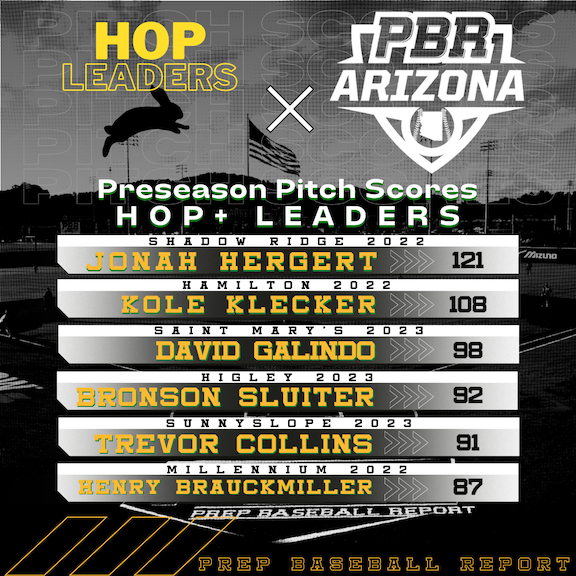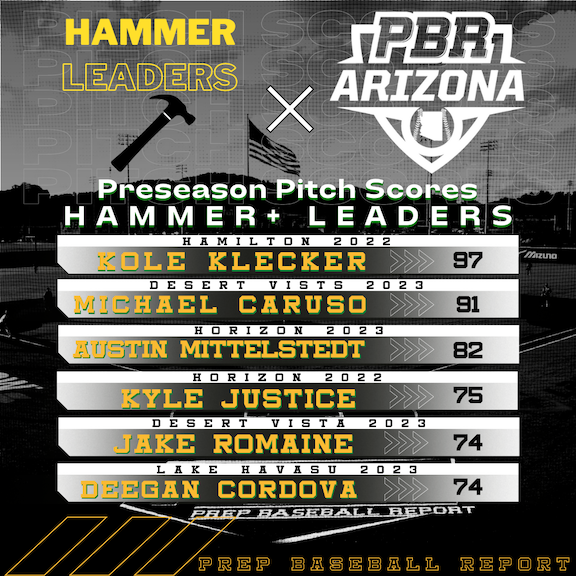January Pitch Score Leaders
March 15, 2022
First released at the start of June 2021, Prep Baseball Report’s data team – led by Zach Day and Joe Dattoli – have been diligently working to find the characteristics that make an individual pitch effective.
We categorize pitches in subjective buckets, self-labeling them as fastballs, curveballs, sliders, and so on. We’ve also gotten great at reading the digits that pop up on radar guns and TV broadcasts, typically near the score and inning somewhere. But there’s still so much more to pitching than raw velocity and spin rate. We’re collecting piles of meaningful information on a daily basis at PBR events, enough to help us generate new ways to evaluate pitch-by-pitch metrics more objectively.
Through our Preseason events held in January of 2022, PBR Arizona really dialed in on these pitch scores, and are now shining some light on the top scores from three different categories: Hop+, Hammer+, and Sink+.
Hop+ leaders
This was the first Pitch Score metric introduced by our data team, unveiled last summer. Here’s a refresher on the metric’s purpose: Up until its release, “hop” was a subjective term used to describe fastballs with “life” or action that appeared to help the pitch gain speed upon entering the strike zone. It was a sought after trait, something that was hard or even deemed impossible to teach. A fastball either had that life through the zone, or it didn’t.
The data team’s goal was to define and quantify hop within a fastball to be able to compare and evaluate hop across all levels, including MLB. So, the Hop Score was born.
Hop Score: A quantification of the level of hop in a fastball. In greater detail, a fastball with hop has a flat vertical approach angle, which creates more rise than run, creating that illusion of jump upon zone entry. Fastballs that exhibit these traits generate more swings and misses, as well as pop ups, especially when located at the top of the zone.

 |
Jonah Hergert RHP / 1B / Shadow Ridge, AZ / 2022Rankings StateRank: 88 / POS: 19
|
 |
Kole Klecker RHP / 1B / Hamilton, AZ / 2022
|
 |
David Galindo RHP / C / Saint Mary's, AZ / 2023Rankings StateRank: 44 / POS: 12
|
Hammer+ Leaders
The Hammer Score was first introduced by the PBR data team last fall, designed to define the action on a breaking ball that we so often refer to as a “hammer.” Breaking pitches with hammer-like qualities typically share in common late movement working off a vertical plane through the strike zone. Our staff’s goal here was to more accurately define that pitch action, and to compare and evaluate breaking balls with effective vertical drop across all levels.
A curveball, or slider for that matter, with a higher Hammer Score has the potential to generate a greater swing-and-miss rate, especially when paired with fastball velocity and fastballs with high Hop Scores. Designing a pitch mix around Hammer and Hop is a common course of action at the Major League level, employed by knockout relievers like Craig Kimbrel, who’ve historically ran high strikeout rates.
Hammer Score: We define hammer, metrically, as a breaking ball that drops vertically with velocity through the strike zone. Breaking balls with high Hammer metrics exhibit acceleration downward off the vertical plane. Our Hammer Scores simplify the way we evaluate vertical breaking balls objectively. The effectiveness of a breaking ball is very dependent on outside factors, including location and pitch repertoire. In general, breaking balls with a higher Hammer Score are more difficult to hit than breaking balls with a lower one.

 |
Michael Caruso RHP / RHP / Desert Vista, AZ / 2023Rankings StateRank: 54 / POS: 14
|
 |
Austin Mittelstedt 3B / RHP / Horizon , AZ / 2023Rankings StateRank: 73 / POS: 9
|
 |
Kyle Justice RHP / 3B / Horizon , AZ / 2022Rankings StateRank: 92 / POS: 20
|
Sink+ Leaders
Two Pitch Scores previously published by our PBR analytics team, Hop and Rise, help capture the efficacy of the traditional four-seam fastball, one that leads to more swings and misses. We’re introducing a third score here to help objectively evaluate the fastballs that rely on horizontal action rather than vertical movement, with the help of the Sink Score.
Until now, the word sink has been used to describe a fastball that visually drops and runs arm-side through the strike zone. Fastballs with extreme sink spin at a lesser rate because of that horizontal action, producing less backspin as a result. Sinking fastballs visually drop through the strike zone generating higher ground ball rates, especially when located at the bottom of the zone. It was the PBR analytics team’s goal to be able to objectively quantify fastballs with sink characteristics across levels.
Sink Score: Sink is most commonly defined as a fastball that visually drops and runs arm-side through the strike zone. With Sink Score, our staff was able to create the Sink+ statistic to normalize our Sink Scores across all levels. We now have a simple way to objectively compare fastballs with sink characteristics between levels and over time with the Sink+ stat. The effectiveness of a fastball is very dependent on outside factors including location and pitch repertoire. In general, fastballs with a higher Sink Score are more difficult for the batter to square up.

 |
J.T. Price SS / RHP / Centennial, AZ / 2025
|
 |
Ryan Weller OF / RHP / Horizon , AZ / 2023Rankings StateRank: 152 / POS: 30
|
 |
LuisPablo Navarro LHP / OF / Walden Grove, AZ / 2024Rankings StateRank: 43 / POS: 3
|
